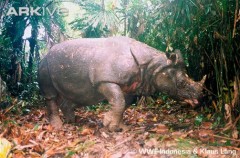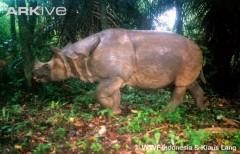Javan rhino is the rarest in the World Wildlife
 Javan rhinoceros (Rhinoceros sondaicus) is one of the world's rarest wildlife species with an estimated total population of no more than 60 individuals in Ujung Kulon National Park (TNUK), and approximately eight individuals in Cat Tien National Park, Vietnam (2000). Javan rhino is also the rarest rhino species among the five species of rhino in the world and entered the Red List of IUCN's world conservation body, namely the category of highly endangered or critically endangered.
Javan rhinoceros (Rhinoceros sondaicus) is one of the world's rarest wildlife species with an estimated total population of no more than 60 individuals in Ujung Kulon National Park (TNUK), and approximately eight individuals in Cat Tien National Park, Vietnam (2000). Javan rhino is also the rarest rhino species among the five species of rhino in the world and entered the Red List of IUCN's world conservation body, namely the category of highly endangered or critically endangered.Rhino is believed to have existed since the Tertiary era (65 million years ago). Like the dinosaurs that are extinct, Rhino at 60 million years ago has 30 types of many extinct. Currently only five remaining rhino species, 2 species of them are in Indonesia.
Different species of rhinos surviving are;
* Sumatran Rhino (Sumatran rhino) horned two or Dicerorhinus sumatrensis. There on the island of Sumatra (Indonesia) and Borneo (Indonesia and Malaysia).
* Javan rhino (Javan rhino) horned one or Rhinocerus sondaicus. There are in Java (Indonesia) and Vietnam
* Indian Rhinoceros (Indian rhino) or Rhinocerus unicornis one-horned. Artifacts in India and Nepal.
* Black African horned Rhinoceros horn (Black Rhino) or Diceros bicormis. There is in Kenya, Tanzania, Cameroon, South Africa, Namibia and Zimbabwe.
* two-horned African White Rhinoceros (White Rhino) or Cerathoterium simum. There in the Congo.
Physical characteristics of the Javan rhino (Rhinoceros sondaicus)
 Javan Rhino generally have a gray body color blackish. Having one horn, with a length of about 25 cm but there probably did not grow or is very small in females. Weight loss a Javan rhino can reach 900 - 2300 kg with a body length of about 2-4 m. Height can reach almost 1.7 m.
Javan Rhino generally have a gray body color blackish. Having one horn, with a length of about 25 cm but there probably did not grow or is very small in females. Weight loss a Javan rhino can reach 900 - 2300 kg with a body length of about 2-4 m. Height can reach almost 1.7 m.Javan Rhino Skin (Rhinocerus sondaicus) have some sort of folds so that it looks like wearing a shield of steel. Having a way similar to the Indian rhinoceros, but the body and smaller head with fewer number of folds. Upper lip is more prominent that could be used to grab food and put it into the mouth. Rhinoceros including shy and solitary type (loner).
Di Indonesia, Badak Jawa dahulu diperkirakan tersebar di Pulau Sumatera dan Jawa. Di Sumatera saat itu badak bercula satu ini tersebar di Aceh sampai Lampung. Di Pulau Jawa, badak Jawa pernah tersebar luas diseluruh Jawa.
Badak Jawa kini hanya terdapat di Taman Nasional Ujung Kulon (TNUT), Banten. Selain di Indonesia Badak Jawa (Rhinocerus sondaicus) juga terdapat di Taman Nasional Cat Tien, Vietnam. Individu terakhir yang di luar TNUT, ditemukan ditembak oleh pemburu di Tasikmalaya pada tahun 1934. Sekarang specimennya disimpan di Museum Zoologi Bogor.
Badak ini kemungkinan adalah mamalia terlangka di bumi. Berdasarkan sensus populasi Badak Jawa yang dilaksanakan oleh Balai TNUK, WWF – IP dan YMR pada tahun 2001 memperkirakan jumlah populasi badak di Ujung Kulon berkisar antara 50 – 60 ekor. Sensus terakhir yang dilaksanakan Balai TN Ujung Kulon tahun 2006 diperkirakan kisaran jumlah populasi badak Jawa adalah 20 – 27 ekor. Sedangkan populasi di di Taman Nasional Cat Tien, Vietnam, diperkirakan hanya 8 ekor (2007).
Populasi Badak bercula satu (Badak Jawa) yang hanya 30-an ekor ini jauh lebih kecil dibandingkan dengan populasi saudaranya, Badak Sumatera yang diperkirakan berkisar antara 215 -319 ekor. Juga jauh lebih sedikit ketimbang populasi satwa lainnya seperti Harimau Sumatera (400-500 ekor), Elang Jawa (600-an ekor), Anoa (5000 ekor).
Javan Rhino Conservation and Protection
Javan Rhino in 1910 as a wild beast has formally reserved by the Government of the Netherlands East Indies, so that in 1921, based on recommendations from The Netherlands Indies Society for Protection of Nature, Ujung Kulon by the Dutch government declared a Nature Reserve. This situation still continues until the status changed to Ujung Kulon Wildlife Reserve under the management of Bureau of Forestry and National Park in 1982.
 Javan rhinoceros (Rhinoceros horned one) who live together in one main area is very vulnerable to extinction that can be caused by disease, natural disasters such as tsunamis, volcanic eruption of Krakatoa, an earthquake. In addition, the rhino is also lack of roaming space and resources due to the invasion Langkap (Arenga) and competition with bulls.
Javan rhinoceros (Rhinoceros horned one) who live together in one main area is very vulnerable to extinction that can be caused by disease, natural disasters such as tsunamis, volcanic eruption of Krakatoa, an earthquake. In addition, the rhino is also lack of roaming space and resources due to the invasion Langkap (Arenga) and competition with bulls.Preliminary research WWF identifies suitable habitat, safe and relatively close to the National Park Mist at Gunung Salak, West Java, which was also the habitat of the Javan rhinoceros. If the second habitat is found, then the rhino a healthy, good, and meet the criteria in Ujung Kulon is sent to the new territory. Habitat will also guarantee the security of the population
Scientific Klasifikaksi: Kingdom: Animalia. Phylum: Chordata. Subfilum: Vertebrates. Class: mammals. Order: Perissodactyla. Superfamily: Rhinocerotides. Family: Rhinocerotidae. Genus: Rhinoceros. Species: Rhinoceros sondaicus (Desmarest, 1822)
A little extra; Rhinoceros derived from the Greek "rhino" meaning "nose" and "ceros" meaning "horn". Sondaicus refers to the Sunda Islands in Indonesia. "Sundanese" means "Java" sedangka "ICUs" in Latin to indicate the location
Reference: www.wwf.or.id; www.badak.or.id; www.iucnredlist.org; Image: www.arkive.org
No comments:
Post a Comment